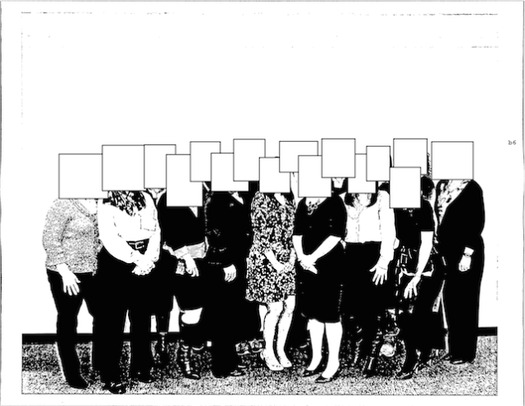
Not long ago, Blackbag.Gawker.com published a set of images that made what has turned out to be a lasting impression on me.
The short version: In the course of reporting a fascinating investigative piece for USA TODAY about how federal prisoners convert "snitching" into a profitable activity, reporter Brad Heath acquired many documents via Freedom of Information Act requests, from the Federal Bureau of Investigation. Among these were a number that, while not ultimately important to Heath's report, are visually fascinating.
Blackbag explains:
Before providing the records to Heath, employees of the bureau’s information dissemination division carefully outlined, then excised, the heads and faces from every photograph ... leaving behind stark and often oddly shaped voids.

The results are, to put it mildly, surreal. Some evidently come from a retirement-party event; others are apparently drawn from a related powerpoint presentation. (The latter are the ones that, with accidental brilliance, are juxtaposed with phrases whose meaning is decisively shifted by the strange new visual context.)
The upshot is a series of bizarrely crude efforts at identity-supression that seem almost like visual comments on privacy and the surveillance state.
Blunt and artless as they are, these efforts do seem effective, no? I'm partly reminded of John Baldessari's "dot" blots. But it's actually the indifference to aesthetics in these images that sets them apart.
I find myself wishing for something like, I don't know, an Instagram filter, that would convert any snapshot to a the stark version of black-and-white that only a photocopy can provide, enhanced by the insertion of clumsy white boxes over anything recognizable as a face. Or maybe a Chrome extension that did something similar to every image in your browswer.
In any case, these images, to me, aren't just curiosities. They are statements about the complex dialogue around privacy and control — who gets to see what? The answer here is unequivocal: A FOIA response that is practically a parody of transparency. Ask all the questions you want; your answer is will be a crystal-clear void.
Imagine if somehow this weird occurence translated into some kind of meme: A visual practice of protesting the official-observation culture that the FBI partly represents, utlizing the the agency's own tactic fending off unwanted eyes — with a simple white, anonymizing box.

